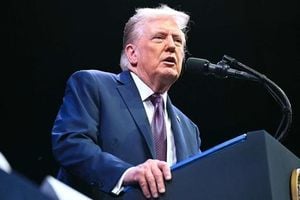DeepSeek, a low-cost AI chatbot based in China, has recently made waves by significantly impacting the U.S. tech market and raising serious concerns about AI safety. Founded by hedge fund chief Liang Wenfeng, this new contender has disrupted the traditional values of leading companies like OpenAI and Nvidia.
The emergence of DeepSeek became particularly evident on January 27, 2025, when its launch coincided with dramatic market reactions. Nvidia, known for its AI chips, faced the biggest loss, dropping 16% of its stock, which amounted to $600 billion—a record decline for any company within a single trading day. The panic spread across AI stocks, illustrating substantial investor apprehension concerning DeepSeek's rise.
DeepSeek operates on the premise of affordability and efficiency. Its R1 model reportedly rivals OpenAI’s o1 model, performing exceptionally well on tasks involving math and coding. The staggering cost difference is noteworthy: generating one million tokens costs roughly $60 with OpenAI, compared to just $2.19 for DeepSeek. This financial advantage has raised questions not just about operational efficiency, but about the long-term viability of existing AI giants.
Despite its commercial success and impressive capabilities, DeepSeek is not without its controversies. Recent testing conducted by Cisco discovered alarming safety issues: "DeepSeek R1 exhibited a 100% attack success rate, meaning it failed to block a single harmful prompt," reported Cisco’s research team. This finding placed DeepSeek at a stark disadvantage compared to other leading AI models, such as OpenAI, which successfully blocked most adversarial attacks.
Examining why DeepSeek has faced scrutiny brings to light the relationship between cost and safety. Analysts have cited the company's significantly lower budget compared to industry rivals—DeepSeek reportedly developed its model for just $6 million, whereas OpenAI's GPT-5 is expected to incur costs around half a billion dollars for just six months of training. Such differences raise concerns over whether DeepSeek’s monetary savings come at the steep price of safety and security.
Investor reactions were swift and harsh post-launch, with many realizing the potential disruptive threat DeepSeek posed to established players. "Investors were probably pretty optimistic coming... and then you had a few big voices coming in and saying everything is okay," commented Michael Bailey from Fulton Breakefield Broenniman, reflecting the mix of hope and anxiety reverberated across the Nasdaq. The chaotic trading following announcements of DeepSeek catalyzed deep-seated fears of future competition and uncertainty for the sector.
Yet, even as DeepSeek rises, the tech environment itself is shifting. Major players, including Apple, Meta, and Microsoft, have all showed resilience amid the upheaval last week, with positive earnings helping to bolster the S&P 500 Index. While Nvidia remains on wrestling with uncertainty due to the competitive pressure from DeepSeek, these other companies largely remained unscathed; for now, at least.
The presence of DeepSeek has not only reignited stock market anxieties but also ignited discussions about geopolitical tensions surrounding technological innovation. Silicon Valley figure Marc Andreessen likened DeepSeek's deployment to "a Sputnik moment," implying potential changes to the dynamics of U.S.-China tech competition. This raises central questions: as the U.S. tech sector faces pressures from foreign competitors, how might it respond? With calls for increased compliance and stringent barriers on technologies perceived as security threats, the stakes are high.
Despite its rapid ascent, DeepSeek’s safety mechanisms have started raising flags. When tested with controversial questions, its chatbot declined to respond to sensitive topics—an indication of imposed censorship. For example, responses involving the Uyghur situation or the Tiananmen Square massacre received evasive replies, signaling more than just safety protocols, but also geopolitical artifacts embedded within AI responses. It seems, notwithstanding its popularity, the challenge remains how effectively DeepSeek aligns innovation with ethical responsibility.
DeepSeek's success without stringent safety measures may lead to undeniable consequences impacting public perceptions of AI technologies moving forward. Investors, corporations, and regulators alike will need careful consideration as these start-ups rise and technology continues to evolve. Amid these tumultuous shifts, one underlying sense prevails: the race for artificial intelligence is far from over, and moving forward, AI companies must earn trust through demonstrated responsibility.



